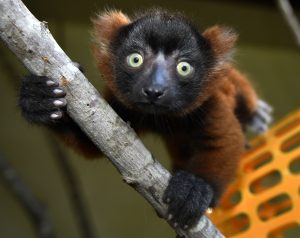
Buzz, a critically endangered red ruffed lemur born at the Duke Lemur Center. Photo by David Haring.
Four Infants Representing Four Different Species Born at Duke Lemur Center
Lemurs are the planet’s most threatened group of mammals. At the Duke Lemur Center, we’re excited to announce that this summer, the population of these endangered primates has increased by an additional FOUR!
In collaboration with other accredited institutions, the Duke Lemur Center works diligently to preserve healthy, genetically diverse populations of each of these species – and each new infant strengthens the “genetic safety net” for their compatriots in the wild. Buzz, Leigh, Shezmu, and Mallard aren’t just cute; they’re crucial to the survival of their species.
Scroll down for more info on each of the DLC’s newest infants – and for additional photos, too! A gallery of all of the DLC’s 2017 infants can be viewed HERE.
![]()
Buzz, red ruffed lemur (critically endangered)
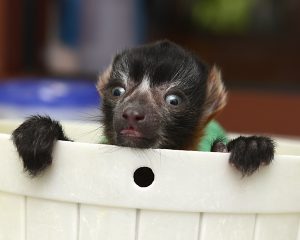
Buzz being weighed. Photo by David Haring.
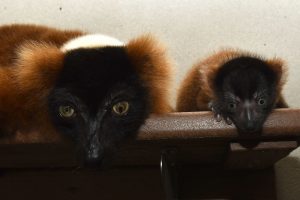
Pyxis with her infant, Buzz. Red ruffed lemurs have an “outer space” naming theme, including stars, planets, and constellations. Buzz’s namesake is astronaut Buzz Aldrin, who walked on the moon with Neil Armstrong in 1969. Photo by David Haring.
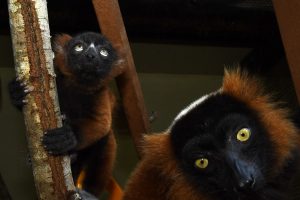
Buzz with his older brother, Bode. Photo by David Haring.
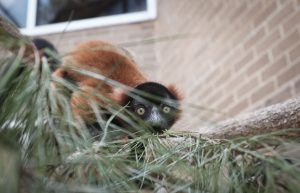
At 1.5 months old, Buzz is playful and curious boy who loves to explore! Photo by Sara Clark.
Meet Buzz! This curious, playful boy was born May 30, 2017 to parents Pyxis and Borealis. 22-year-old Pyxis is a fabulous mom, in addition to being one of our older females. She and Borealis (age 27) are an aged pair, though by no means record-setters: the DLC has had females as old as 24 conceive infants, and males as old as 31 have sired them! Ruffed lemurs live an average of 15-20 years in the wild. At the Duke Lemur Center, where they have access to the best food, housing, and care, they live much longer… One of our red ruffed lemurs, Saturna, lived 37 years!
Red ruffed lemurs are CRITICALLY ENDANGERED in Madagascar, primarily due to habitat loss and bushmeat hunting. Sadly, the forest is being destroyed by desperately poor families using slash-and-burn agriculture (tavy) to clear land for subsistence farming, and ruffed lemurs and other species are also being hunted for food. As Jonah Ratsimbazafy, a lemur expert and DLC collaborator in Madagascar, tells the Los Angeles Times: “We have a saying here: ‘An empty stomach has no ears.’ If people can’t eat, how can you save the lemurs?’”
As a result, the Duke Lemur Center is teaching communities in Madagascar how to set up ponds for farming native fish as an alternative protein source to bushmeat, in addition to promoting more sustainable forms of agriculture. Yams, for example, reduce erosion, are more resistant to tropical cyclones, and don’t require burning the forest like traditional rice farming does. You can learn more about the DLC’s work in Madagascar HERE.
Genetically, Pyxis and Borealis are very important to the red ruffed lemur Species Survival Plan. We’re thrilled to welcome their newest infant, Buzz, into the world!
![]()
Leigh, blue-eyed black lemur (critically endangered)
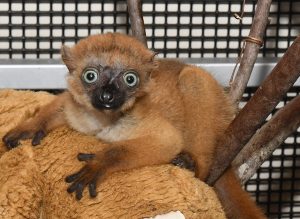
Leigh, a critically endangered blue-eyed black lemur born 5/11/17 to parents Margret and Tarantino. In 2015, it was estimated that the blue-eyed black lemur could go extinct in the wild as little as 11 years. Photo by David Haring.
It’s been a banner year for blue-eyed black lemurs at the DLC! This spring, we welcomed infants McKinnon and Poehler; now, a few months later, we’re introducing little Leigh! The blue-eyed black lemur is CRITICALLY ENDANGERED in Madagascar, with a mere FOUR blue-eyed black females of breeding age in North America. Of those, three live at the Duke Lemur Center – and we are ELATED that all three have welcomed healthy infants in 2017!
You can learn more about blue-eyed black lemurs in our press release celebrating the births of McKinnon and Poehler. You can also support the care of our blue-eyed black lemurs by “adopting” Presley, a male BEB lemur, through the DLC’s Adopt A Lemur program! Adoption packages start at just $50 and include photos and quarterly updates about Presley and his family.
![]()
Shezmu, crowned lemur (endangered)
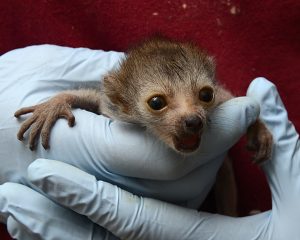
Shezmu, an endangered crowned lemur born 5/25/17. Photo by David Haring.
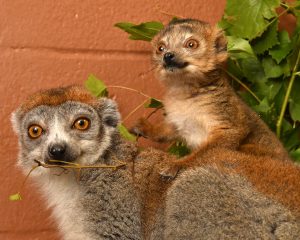
Shezmu joins Ma’at (born 4/29/17 to parents Seshat and Mosi) as our two crowned lemur infants of the season. Pictured at 72 days old, Ma’at is thriving and spending a lot of time off of mom on his own. Here he enjoys the security and added vantage point of his mom’s back as he samples fresh grape leaves. Photo by David Haring.
In November 2016, 2.5-year-old Sanura arrived at the DLC from the Cleveland Zoo. After clearing quarantine, she was introduced to two brothers, 3.5-year-old Xonsu and 2.5-year-old Zuberi. Xonsu took an immediate and intense shine to Sanura, and he actively discouraged his brother from doing likewise… but alas for poor Xonsu, the crowned lemur Species Survival Plan had previously selected him for pairing with a young female at Chicago’s Lincoln Park Zoo, while Zuberi was chosen as the lucky one to be paired with the lovely Sanura.
… Needless to say, it was a perfect match! On May 25, little Shezmu was born to parents Sanura and Zuberi. This being Sanura’s first infant, at first she wasn’t sure what he was or what to do with him. A little one-on-one time alone in a kennel helped momma and baby bond, and both are doing wonderfully!
Shezmu joins Ma’at (born on April 29 to parents Seshat and Mosi) as our two crowned lemur infants of the season. Both boys are growing well and enjoying life with their parents and families.
![]()
Mallard, fat-tailed dwarf lemur
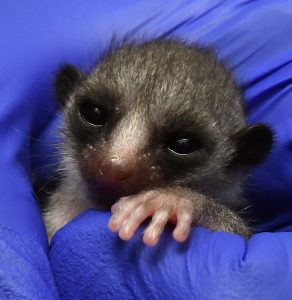
Mallard, born 6/12/17. Photo by David Haring.
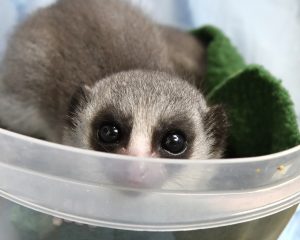
Mallard is growing like a weed! He’s pictured here during a routine weighing. Photo by David Haring.
Meet Mallard, born June 12, 2017 to parents Raven and Francolin! He’s cute as a button and growing like a weed!
Mallard’s father, Francolin, is genetically the most important male fat-tailed dwarf lemur at the DLC. He’s the sole offspring of Towhee, one of our original females, so encouraging him to breed is so important – and we’re thrilled with the (adorable!) results!
The Duke Lemur Center houses the only breeding colony of dwarf lemurs in North America, where they’re the subjects of some very fascinating non-invasive research on torpor. This is because fat-tailed dwarf lemurs are the world’s only hibernating primates.
You might remember Mallard’s momma, Raven, as our “movie star lemur” who made her big screen debut in the IMAX documentary Island of Lemurs: Madagascar! You can support the care of the DLC’s fat-tailed dwarf lemurs by “adopting” Raven through our Adopt A Lemur program. Adoption packages start at just $50 and include photos and quarterly updates about Raven and her family.
![]()
Did you know…
It costs $7,400 per year to feed, house, and care for each lemur at the Duke Lemur Center. Please consider making a donation or symbolically adopting a lemur today. Your gift at any level makes a difference!

